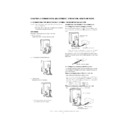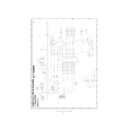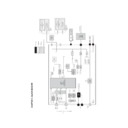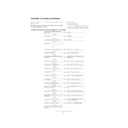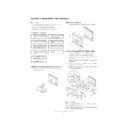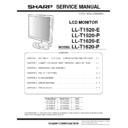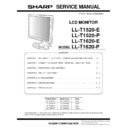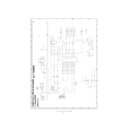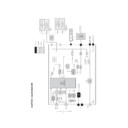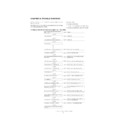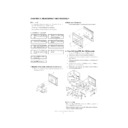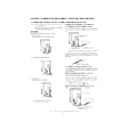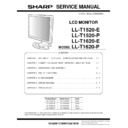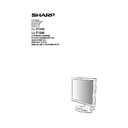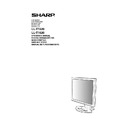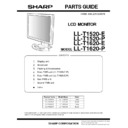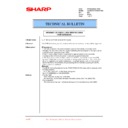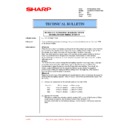Read Sharp LL-T1620 (serv.man12) Service Manual online
PC-UM10M
LL-T1520-H/B LL-T1620-H/B CONNECTION, ADJUSTMENT, OPERATION, AND FUNCTIONS
2 – 1
CHAPTER 2. CONNECTION, ADJUSTMENT, OPERATION, AND FUNCTIONS
1. CONNECTING THE MONITOR AND TURNING THE MONITOR ON AND OFF
Caution: • When connecting, ensure that both the monitor and com-
puter are switched off.
• Be careful not to overly bend the cable or add extension
cords as this could lead to malfunction.
Cable storage
If necessary, excess cable can be housed in the stand.
1.
Remove the cover.
Gently pull the top of the cover towards yourself.
2.
Run cable along the back of the stand.
3.
Refit the cover.
Be careful not to pinch the cable.
• If the cover is hard to refit, do not force it.
Check whether cables are trapped.
CONNECTING THE MONITOR TO A COMPUTER
Connecting using accessory analog signal cable
Connect the accessory analog signal cable to the analog RGB input ter-
minal of the display, and the analog RGB output terminal of the com-
puter.
puter.
• Paying attention to connector direction, firmly insert the signal
cable to terminal, and then tighten the screws at both sides.
If connecting to a D-sub 15 pin 2 row Apple Power Macintosh, attach a
Macintosh conversion adapter (commercially available) to the analog
signal cable.
signal cable.
Connecting using a separately sold display cable
The separately sold display cable enables connection between the DVI-
I input terminal on the display and the digital or analog RGB output ter-
minal of the computer.
When connecting to a digital RGB output terminal:
• Use a digital signal cable (model name: NL-C01E)
• The monitor can be connected to the following computers that have a
DVI standard output terminal (DVI-D24 pin or DVI-I29 pin) for digital
connection. (Note that the display may not appear correctly, depend-
ing on the connected computer.)
-- LL-T1520: Computers capable of XGA output
-- LL-T1520: Computers capable of XGA output
-- LL-T1620: Computers capable of SXGA output
When connecting to an analog RGB output terminal:
• Use an analog signal cable (model name: NL-C02E).
Analog signal cable
Analog RGB input
terminal
terminal
Analog RGB output terminal
Macintosh conversion adapter
DVI-I input terminal
RGB output terminal
Display cable
(to be purchased separately)
(to be purchased separately)
PC-UM10M
LL-T1520-H/B LL-T1620-H/B CONNECTION, ADJUSTMENT, OPERATION, AND FUNCTIONS
2 – 2
• Paying attention to connector direction, firmly insert the signal
cable to terminal, and then tighten the screws at both sides.
Set the monitor as follows when establishing a digital connection with a
Power Mac using an ADC-DVI adapter made by Belkin. (Operation has
been checked with the Power Mac G4 M7627J/A)
been checked with the Power Mac G4 M7627J/A)
• Perform settings with the Power Mac power supply off.
• The setup screen automatically disappears approximately 30 sec-
onds after the last command.
1.
After connecting the power cord, turn on the monitor’s main power.
2.
Press the
e
button and
d
button simultaneously, and while doing
this press the POWER button (i.e. turn the power on).
3.
Set to “ON” with the
e d
buttons.
• Do not set to [ON] if you are not using a Belkin ADC-DVI adapter, as
this may result in incorrect display.
4.
Press the MENU button.
This completes setting.
CONNECT THE ACCESSORY AUDIO CABLE
When the accessory audio cable is connected to the audio output termi-
nal of the computer, the sound of the connected computer is output
from the display speakers. You can also use the headphone jack of the
display.
display.
• If you plan to use a commercially available cable, obtain one with no
resistance.
CONNECTION OF HEADPHONES
(COMMERCIALLY AVAILABLE)
(COMMERCIALLY AVAILABLE)
Headphones (commercially available) can be connected.
Note: When the headphones are connected, no sound can be heard
from the monitor speakers.
CONNECTING THE MONITOR TO A POWER SOURCE
TURNING THE POWER ON
1. Turn on the main power of the monitor.
• When switching the main power switch on and off, always wait
for an interval of at least 5 seconds. Rapid switching may result
in malfunction.
2. Press the monitor’s POWER button.
The power LED will light up orange.
3. Turn on the computer.
When a signal is input from the computer, the power LED lights up
green, and the screen is displayed (After power is turned on, it may
take a little time until the screen is displayed.)
• If the input terminal to which the computer is connected has not
been selected, the screen will not be displayed. If necessary,
perform input terminal switching.
Notes: (when using an analog signal)
• If using the monitor for the first time or after having changed the sys-
tem settings during use, perform an automatic screen adjustment.
• When connecting to a notebook, if the notebook computer’s screen is
set so that it is displaying at the same time, the MS-DOS screen may
not be able to display properly. In this case, change the settings so
that only the monitor is displaying.
MAC DIGITAL
INPUT-2
OK [ MENU ]
ON
OFF
Audio cable
Audio output terminal
Audio input
terminal
terminal
Headphones
Headphone
terminal
terminal
Power cord
AC outlet
Power terminal
Main power switch
Turn on the computer
power supply.
power supply.
Press power button
PC-UM10M
LL-T1520-H/B LL-T1620-H/B CONNECTION, ADJUSTMENT, OPERATION, AND FUNCTIONS
2 – 3
CHANGING BETWEEN INPUT TERMINALS
Use the INPUT button to switch between signal input terminals.
TURNING THE POWER OFF
1. Turn the computer off.
2. Press the monitor’s POWER button.
The Power LED will disappear.
If the monitor will not be used for a long time, turn off the main power
switch of the monitor, and remove the power plug from the outlet.
2. INSTRUCTIONS FOR ATTACHING A VESA COMPLIANT ARM
An arm or stand based on the VESA standard (commercially available)
can be attached to the monitor.
Procurement of the arm or stand is at the customer’s discretion.
Arms or stands able to be used
Attachments must satisfy the following.
• Compatible with the VESA standard
• Have a gap of 75 mm x 75 mm between the screw holes on the sec-
tion to be attached
• Not be likely to fall off or break off after being attached to the monitor.
How to attach the arm or stand
• Be careful not to overly bend the cable or add extension cords as this
could lead to malfunction.
• While following these instructions, please also refer to the installation
instructions in the operation manual included with the arm or stand.
1.
Turn off the monitor’s power and unplug AC plug from AC outlet.
2.
Remove the cable.
3.
Spread out a soft cloth on a suitable horizontal surface.
4.
Being careful not to damage the monitor, gently lay the monitor on it
display-side down.
5
Remove the four screws and then remove the stand from the moni-
tor.
Notes: • The stand is specially made for use with this monitor. Once
having removed the stand, never attempt to attach it to
another device.
another device.
• Once having removed the screws, store them together with
the stand and if the stand is ever re-attached be sure to use
the original screws. Using different screws could lead to a
malfunction.
malfunction.
6. Attach the arm to the monitor with the four screws.
Note: The screws used to attach the arm should be M4 screws with a
length of 6 mm ~ 8 mm protruding from the surface to be
attached. Using different screws could lead to malfunction or may
lead to the monitor falling off, internal damaged, personal injury.
lead to the monitor falling off, internal damaged, personal injury.
INPUT-1
<ANALOG>
INPUT
INPUT-2
<ANALOG>
INPUT-2
<DIGITAL>
Analog RGB input terminal
DVI-I input terminal
(digital)
DVI-I input terminal
(analog)
Press power button
Turn on the
computer off
computer off
6 ~ 8 mm
Screw used to attach arm
Arm
Part of monitor to which
arm is attached
arm is attached
PC-UM10M
LL-T1520-H/B LL-T1620-H/B CONNECTION, ADJUSTMENT, OPERATION, AND FUNCTIONS
2 – 4
3. ADJUSTMENT
3-1. ADJUSTMENT METHOD
6) Version display (for service)
Power ON
Display the software version.
With the version displayed, no button operations are valid.
7) Test 1 (for service)
Power
ON
Blue
H
Green
H
Red
H
Dark blue
H
Dark green
H
Dark red
H
White
H
Black
8) Test 2 (for service)
Red
H
Green
H
Blue
H
White
H
Black
H
Flicker pattern
H
Checker pattern
H
Gray scale
When the test is terminate, Power off
4) Adjusting the Backlight or Volume
1) Resetting all adjustment values
Power ON
Power ON
Press the above two buttons at same time, and while turn the power on.
2) ADJUSTMENT menu reset
Press the two buttons at same time.
3) Adjustment lock function
While pressing the MENU button, turn the power on.
5) Screen adjustment
MENU
ADJUSTMENT
AUTO
SELECT
CLOCK
SELECT
PHASE
SELECT
H-POS
SELECT
V-POS
SELECT
SELECT
HUE
SELECT
SELECT
SELECT
SATURATION
MENU
GAIN
CONTROL
(For ANALOG)
CONTROL
(For ANALOG)
AUTO
SELECT
BLACK LEVEL
SELECT
CONTRAST
MENU
COLOR
CONTROL
CONTROL
COLOR MODE (sRGB, STD, VIVID)
COOL STD
WHITE BALANCE
WHITE BALANCE
WARM USER
SELECT
R-CONTRAST
SELECT
SELECT
G-CONTRAST
B-CONTRAST
MENU
MODE SELECT
400 LINES
SCALING
MENU
MENU
SELECT
(for ANALOG)
buttons
buttons
buttons
buttons
buttons
buttons
buttons
buttons
buttons
buttons
buttons
buttons
buttons
END
SELECT
VOLUME
BRIGHT
buttons
buttons
OSD V-POSITION
SELECT
buttons
OSD H-POSITION
buttons
buttons
buttons
SELECT
LANGUAGE
(English, German, French, Dutch,
Spanish, Italian, Swedish, Japanese)
Spanish, Italian, Swedish, Japanese)
MENU
button
SELECT
+
MENU
MENU
+
< VERSION & CHECK SUM >
VERSION : 1.04 (20020411)
CHECK SUM : OK A02D
HS
MENU
DIAG TOOL MENU
AGING TEST 1
AGING TEST 1
SET••• [MENU]
SELECT
SELECT
MENU
3

